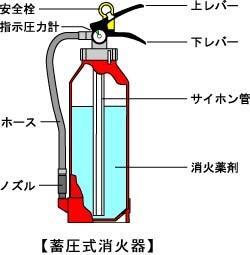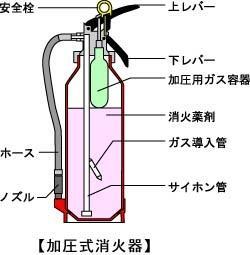Proper maintenance, inspection, and disposal of fire extinguishers
Please be careful of accidents with old fire extinguishers!
Serious accidents have occurred in the country due to the operation of old and corroded fire extinguishers, resulting in injuries or fatalities from explosions. Please do not handle old fire extinguishers that are deformed or damaged, and consult with the fire extinguisher manufacturer or Business Operators.
1 Regular Inspections
Regardless of the useful life, caution is necessary when there is corrosion, damage, or deformation on the fire extinguisher. When inspecting the installed fire extinguishers, pay attention to the following points.
2 Location
Avoid places with high humidity, direct sunlight, and near fire equipment.
Place it in a location that is easy to see and can be used immediately in case of an emergency.
Please be careful not to fall.
3 Disposal Method
Fire extinguishers that are no longer needed cannot be collected as general waste by the city.
The disposal of fire extinguishers is carried out in cooperation with local sales agents (designated contact points) by the Japan Fire Extinguisher Manufacturers Association, so please contact your nearest contact point.
You can find nearby retailers from the website of the Fire Extinguisher Recycling Promotion Center Co., Ltd.
Proper maintenance, inspection, disposal, etc.
Fire extinguisher explosion accidents primarily occur when handling or disposing of extinguishers that have corroded over time due to insufficient maintenance. Therefore, let's enhance the information displayed regarding proper maintenance, inspection, and disposal, and also review the inspection contents to implement safety measures.
The inspection standards have been changed (Effective April 1, 2011)
- Relaxation of internal and functional inspections of pressurized fire extinguishers (see Table 1)
(Relaxation of inspections from every 3 years after the year of manufacture to every 5 years) - Additional pressure performance inspection (hydrostatic test) for fire extinguishers and similar items that have been in use for 10 years (see Table 1)
Note: For fire extinguishers that were installed in fire prevention objects before the enforcement date and have been manufactured for 10 years or more, pressure performance inspections can be conducted using a sampling method for the first three years after installation, provided there is no corrosion found during the visual inspection. The sampling will be done in such a way that the confirmation of all units is completed within three years, generally extracting from the older manufacturing years. (See Table 2)


About Stored Pressure Fire Extinguishers and Pressurized Fire Extinguishers

Pressure accumulator type
The main container is pressurized with fire extinguishing agents and nitrogen gas (or compressed air) as the pressure source. The fire extinguishing agent is released from the nozzle by operating the lever.
It is said to be safe because pressure is always applied to the main container, so there is no pressure applied when operated.

Pressure Type
By gripping the lever of the fire extinguisher, the gas in the pressurizing gas container spreads throughout the fire extinguisher via the gas introduction pipe, and the extinguishing agent is released from the nozzle through the hose from the siphon pipe.
Under normal circumstances, there is no pressure on the main container, but when operated, a sudden high pressure is applied. Therefore, if the container has rust, corrosion, or scratches, or if the extinguishing agent becomes clogged, there is a risk of explosion.
About General Households
- Note: Please be careful
There are no obligations for compliance with the new standards or pressure inspections for fire extinguishers for general household use.
There are companies that conduct door-to-door sales and inspections of expensive fire extinguishers with skillful rhetoric.- They pose as firefighters and say, 'We are from the fire department,' pressuring you to install fire extinguishers and selling overpriced or substandard products.
- "Your home's fire extinguisher does not meet current standards."
- This fire extinguisher has not been regularly inspected, so it must be replaced with a new one.
- Note: Please be careful with such words!
- If you think "This seems suspicious!!", please do not sign or stamp anything. If you make a contract or purchase, be sure to keep the contract, delivery note, and receipt.
- If you feel pressured by aggressive sales tactics or have questions or concerns about a purchase, please contact the fire department or the Consumer Affairs Center.
When disposing of fire extinguishers
- In our city, fire extinguishers are not collected as regular waste.
- The disposal of fire extinguishers is carried out in cooperation with local sales agents (designated contact points) by the Japan Fire Extinguisher Manufacturers Association, so please contact your nearest office.
- Fire Extinguisher Recycling Promotion Center Co., Ltd. You can find a nearby retailer from the website.
Inquiries and Questions
Inagi Fire Station Prevention Division Inspection Guidance Section
Phone 042-377-7119 (Extension 28, 29)
Please let us know your feedback on how to make our website better.
Inquiries about this page
Inagi City Fire Department Prevention Division
〒206-0802 2111 Higashi-Naganuma, Inagi City, Tokyo (Inagi Fire Station)
Phone number: 042-377-7119 Fax number: 042-377-0119
Contact Us for the Inagi City Fire Department Prevention Division



















